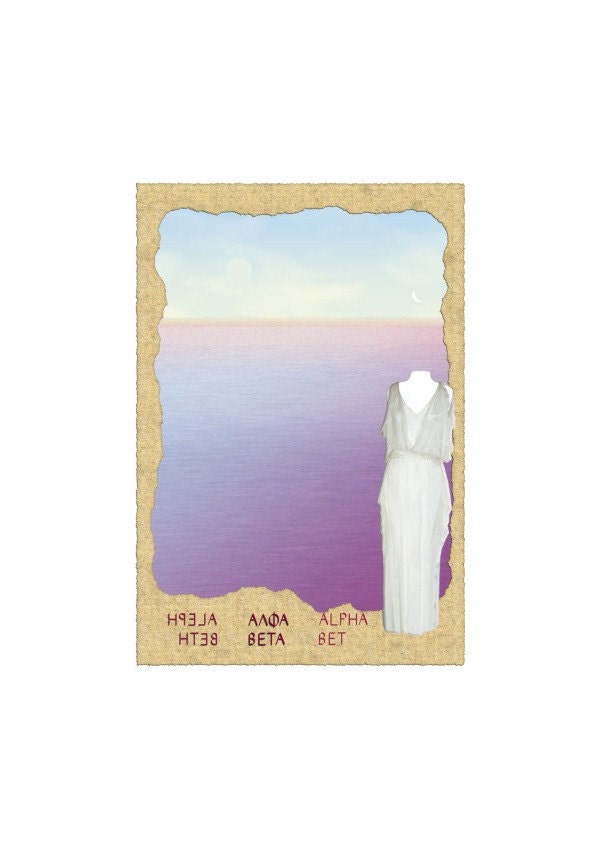This image was inspired by the study of Classical Greek that was part of Anne's Open University Diploma in Classical Studies. During one of the courses there was some information in the Resources folder about the roots of the letters of the Greek alphabet. This led her to do some further reading.
The Phoenicians from the land of the rising sun (the Levant, part of the Fertile Crescent) sailed the Mediterranean. They traded in papyrus amongst other products, and in a purple dye which comes from a sea mollusc called murex. This dye was often used to dye the robes of priests and kings, and was sometimes called Tyrian purple. The Phoenicians traded with the Greeks and through this trade, the ancient Greeks became familiar with the Phoenician alphabet and adapted it for their own language. The Phoenician script was written right to left. The Greeks wrote from left to right so they flipped the letters so that they can be read when writing left to right. The Greeks also added symbols for vowels because the Phoenician alphabet uses diacritics to indicate vowels rather than having a letter for each vowel as in Western alphabets such as the Greek and Latin.
The Latin alphabet which we use today, evolved from the Greek letters and many other Indo-European alphabets have roots in the Phoenician alphabet.
The Greek statue in the image is a photo of one of Anne's apparel designs on a dressmaker’s dummy. She created the dress several years before the call out for the show, from leftovers from a dress she designed for a client. Some of the pieces looked like the shape of draped sleeves on a Greek robe, so she created a Greek style robe with all the leftovers.
So she already had her own design for a Greek style robe to start the picture. She edited the photo of the dress with photo editing software so that it looks like an old statue (well, a bit like bas-relief). She created the letters with drawing software and made the rest of the image using painting and photo software.
The image was created in response to a call for artists by Tunbridge Wells Museum and Art Gallery for their Roots exhibition in the summer of 2008. Artists were requested to send a written proposal before creating an image. The Council were happy for her to proceed with creating a picture based on her proposal. When the image was complete she then submitted it to the judges for the second phase of the selection process. AlphaBeta was selected by them to be shown along with other selected works for the Roots show.
The image is available to order from Anne Fontenoy as open edition giclée prints A3 image with small plain borders @ £60 with an off white acid free back mat or A4 image with small plain borders on off white back mat @ £30 + P&P. Image sizes are approximate. It is also available as a blank inside greeting card @ £3, 5 for £12 of the same image.
Cards can be purchased from the Shop on this website in the Other handmade cards section. Send a message for details of how to order prints.
References: The Open University (2003) A396 Continuing Classical Greek, Milton Keynes, The Open University From Wikipedia: Phoenician Alphabet Tyrian Purple Murex The Wikipedia articles are licensed for release under the Creative Commons Attribution-Share-Alike License (CC-BY-SA) the full text of which can be read on the following website: Creative Commons That license applies only to the text from Wikipedia and not to the text on this page nor the image AlphaBeta created by Anne Fontenoy to whom that copyright belongs.
